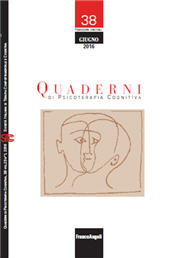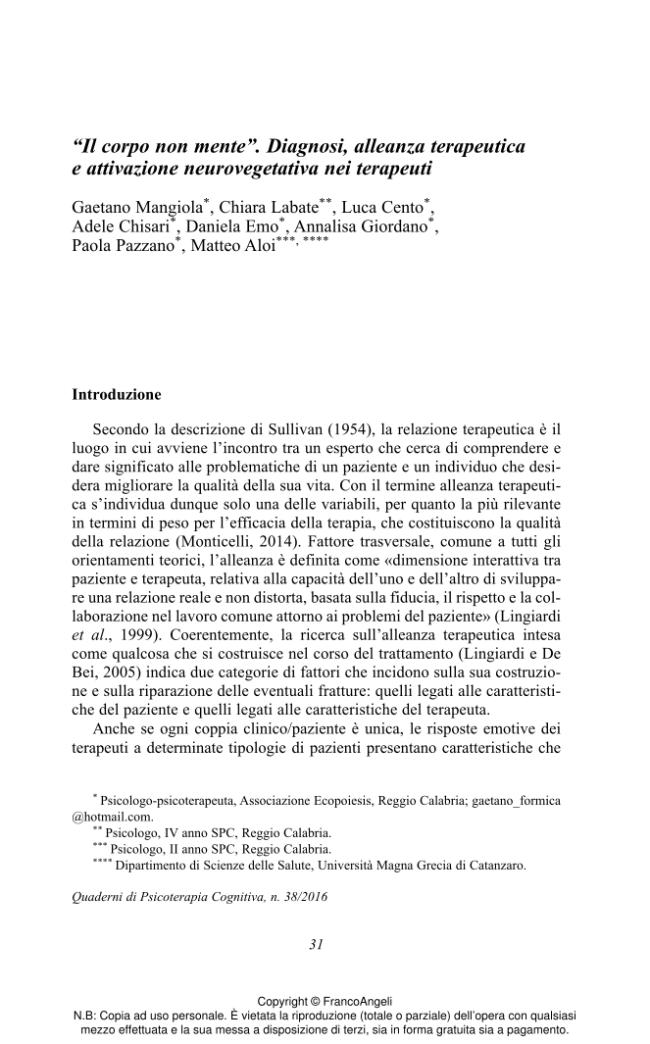Il corpo non mente : diagnosi, alleanza terapeutica e attivazione neurovegetativa nei terapeuti
31-41 p.
Autori diversi e con diverso orientamento teorico si trovano concordi nel riconoscere nell'esperienza che il terapeuta ha del paziente, uno dei più potenti indicatori dello stato mentale del paziente stesso. Delle componenti che caratterizzano lo stato mentale, quella corporea oltre ad essere l'indicatore più valido da misurare, è un potente mezzo di comunicazione non verbale e per questo può essere soggetta alla stessa disciplina suggerita per la lettura e modulazione delle componenti cognitiva ed emotiva al fine della regolazione dell'alleanza terapeutica (Semerari, 1999). L'obiettivo di questo studio esplorativo è quello di indagare la relazione tra diagnosi, attivazione neurovegetativa del terapeuta durante la seduta e qualità dell'alleanza. Per farlo, cinque terapeuti esperti, soci del Centro Clinico di Psicoterapia Cognitiva "Ecopoiesis", hanno monitorato per quattro settimane consecutive i propri indici neurovegetativi (battito cardiaco, pressione, cicli respiratori e tensione muscolare) prima e dopo o
gni sessione di psicoterapia, con 67 pazienti con differenti diagnosi. La qualità dell'alleanza è stata misurata attraverso la somministrazione dello STAR (Scale To Assess Therapeutic Relationships) nella versione per il paziente e per il clinico. L'ipotesi di ricerca è che, così come avviene per la risposta emotiva (Betan et al., 2005; Colli et al., 2014), pazienti con diagnosi simile provochino nei terapeuti una simile attivazione neurovegetativa con una ricaduta sulla valutazione dell'alleanza. Contrariamente alle aspettative, i dati indicano che sebbene esista una relazione tra la qualità dell'alleanza e l'attivazione dei terapeuti, essa sia indipendente dalla diagnosi.
Different authors agree in recognizing that one of the most influential indicators of a patient's mental state is the therapist's experience of her patient. The most influential indicator to measure in this sense is the physical component characterizing the mental state, which is also a powerful means of non-verbal communication. For this reason, the body can be used to read and modulate cognitive and affective components (Semerari, 1999). The aim of this explorative study is to investigate if there is a correlation between the diagnosis, the therapist's physical activation during the session and the quality of the therapeutic alliance. Five expert therapists (members of the Clinical Center of Cognitive Therapy "Ecopoiesis" in Reggio Calabria) monitored their physical index (pulse, pressure, breathing and muscle tension) for four consecutive weeks, before and after each session of therapy with 67 patients having different diagnoses. The quality of the therapeutic alliance was measured with the Scale To Assess
Therapeutic Relationships (STAR) in the patient and clinician version. The hypothesis is that, just as it happens for the emotional reaction (Betan et al., 2005; Colli et al., 2014), patients with similar diagnoses trigger a similar neurovegetative reaction in therapists with a relapse on alliance assessment. Contrary to all expectations, the data collected suggests that there is a relation between the quality of the alliance and the activation of the therapist, but it is not correlated with the diagnosis.
Forma parte de
Quaderni di Psicoterapia Cognitiva : 38, 1, 2016-
Artículos del mismo número (disponibles individualmente)
-
Información
Código DOI: 10.3280/QPC2016-038003
ISSN: 2281-6046
MATERIAS
KEYWORDS
- Alleanza terapeutica, arousal neurovegetativo, diagnosi
- Therapeutic alliance, neurovegetative activation, diagnosis



